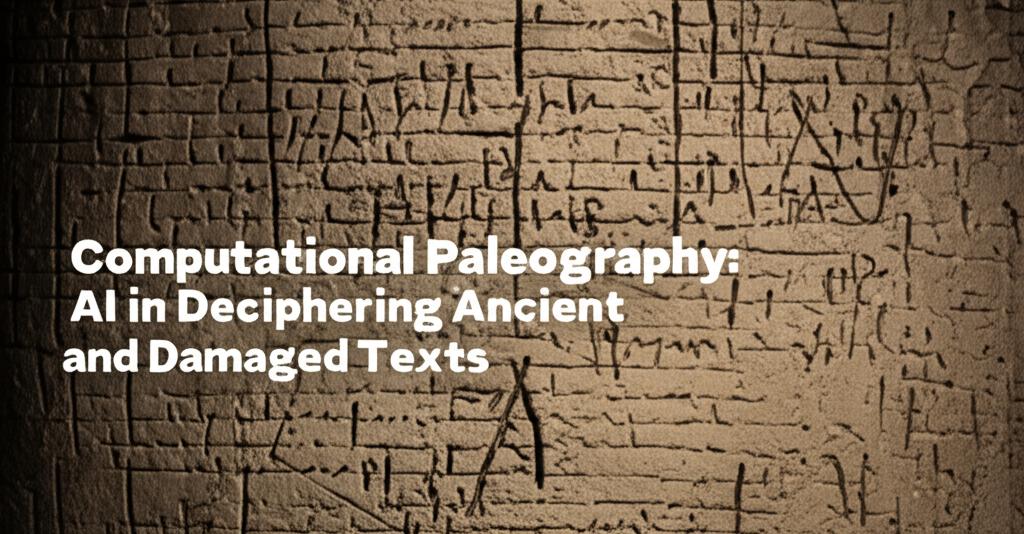Artificial intelligence (AI) is revolutionizing the field of paleography, offering powerful new tools to decipher and understand ancient and damaged texts. This technology accelerates the work of historians, archaeologists, and linguists, opening new windows into past civilizations.
AI's Role in Deciphering and RestorationAI, particularly machine learning (ML) and neural networks, plays a critical role in several areas:
- Optical Character Recognition (OCR) and Handwritten Text Recognition (HTR): AI-powered OCR and HTR systems are being trained to recognize and transcribe ancient scripts, including complex handwritten characters and those on damaged or deteriorated materials. These systems can digitize vast archives of historical documents much faster than humanly possible.
- Reconstructing Damaged Texts: AI algorithms excel at pattern recognition, allowing them to predict and fill in missing or illegible parts of manuscripts. This is particularly useful for texts damaged by fire, water, or time, such as the Herculaneum scrolls, which were carbonized by the eruption of Mount Vesuvius. Researchers have used advanced scanning techniques like X-ray imaging combined with AI to virtually unwrap and read these fragile scrolls without physically destroying them.
- Identifying and Classifying Scripts: AI can analyze the stylistic features of handwriting to help date, locate, and even authenticate historical documents. This "artificial paleography" uses computational methods to compare scripts against known examples, identifying script types and variations across different regions and time periods.
- Analyzing Large Datasets: AI can process and analyze enormous volumes of textual data, identifying linguistic patterns, connections between texts, and even predicting the origins of undated documents. This is invaluable for understanding ancient languages, dialects, and cultural practices. For example, AI has been used to analyze Linear B, the script of the Mycenaean Greeks, revealing regional variations and changes over time. Similarly, AI is assisting in the analysis of cuneiform tablets and the vast archives of the Joseon dynasty.
- Deciphering Unknown Languages: While challenging, AI offers new approaches to deciphering previously unreadable scripts, such as the Indus script. By comparing unknown scripts with known languages and identifying recurring patterns, AI can generate hypotheses about their structure and meaning.
- Herculaneum Scrolls: A significant breakthrough involves using AI to read the Herculaneum scrolls. The Vesuvius Challenge, a competition to decipher these texts, has seen teams successfully use AI to detect ink on the carbonized papyri from high-resolution scans, revealing previously unreadable Greek philosophical texts.
- Dead Sea Scrolls: AI has been instrumental in enhancing the legibility of the Dead Sea Scrolls. Algorithms help reconstruct damaged text and distinguish between different scribal hands, offering new insights into these important religious and historical documents.
- Cuneiform Tablets: AI systems like ProtoSnap are being developed to recognize and reconstruct cuneiform characters, even accounting for variations in writing styles. This technology could vastly expand the number of translated cuneiform texts, shedding light on ancient Mesopotamian life.
- Greek Inscriptions: Models like Oxford University's Ithaca are helping to restore damaged Greek inscriptions and re-evaluate their dating, contributing to ongoing scholarly debates.
Despite the remarkable progress, computational paleography faces challenges:
- Data Availability and Quality: Training AI models requires large, high-quality datasets of digitized manuscripts and accurate transcriptions, which can be scarce for some ancient languages and scripts.
- Algorithm Accuracy and Bias: Ensuring the accuracy of AI interpretations and avoiding biases present in the training data is crucial. Errors in interpretation could lead to significant misrepresentations of historical texts.
- Ethical Considerations: Decisions about restoring or reinterpreting texts carry ethical weight. It's vital to maintain the historical authenticity of documents and ensure that digital interventions are appropriate and beneficial.
- Need for Interdisciplinary Collaboration: The most successful projects involve close collaboration between computer scientists, paleographers, historians, and linguists. Human expertise remains essential for interpreting complex contexts and validating AI-generated results.
The future of computational paleography is promising. As AI technology continues to evolve, more advanced systems will enable increasingly accurate and detailed interpretations of ancient texts. This will not only deepen our understanding of the past but also democratize access to historical knowledge, allowing a wider audience to engage with global cultural heritage. Ongoing research, open-source data sharing, and interdisciplinary efforts will be key to unlocking the full potential of AI in deciphering humanity's ancient written legacy. Workshops and conferences, such as the International Conference on Document Analysis and Recognition (ICDAR) and its Workshop on Computational Paleography, continue to foster these vital collaborations.

